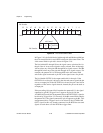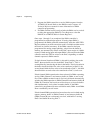
Chapter 5 Programming
©
National Instruments Corporation 5-43 AT-MIO-16X User Manual
Interrupt Programming
Seven different interrupts are generated by the AT-MIO-16X board:
• Whenever a conversion is available to be read from the ADC FIFO
• Whenever the ADC FIFO is more than half-full
• Whenever a data acquisition sequence completes
• Whenever a DMA terminal count is received
• Whenever a falling edge on the TMRTRIG* pin of the Am9513A
is detected
• Whenever the DAC FIFO is less than full
• Whenever the DAC FIFO is half-full
These interrupts can be enabled either individually or in any
combination. In any of the interrupt modes, it is a good practice to
confirm the source of the interrupt through reading Status Register 1. If
ADC FIFOEF* or ADC FIFOHF* is true, a conversion interrupt has
occurred. Reading from the ADC FIFO Register clears these interrupt
conditions. Writing to the DAQ Clear Register also clears these
conversion interrupts. If DAQCOMP is set, the interrupt results from
the completion of a data acquisition operation. This interrupt is cleared
by writing to the DAQ Clear Register. If TMRREQ is set, a DAC update
interrupt has occurred. Writing to the TMRREQ Clear Register clears
this interrupt condition. In the case that waveform generation is
disabled in Command Register 2, the DACs are not updated and the
TMRREQ signal can be used as a timer interrupt. If DMATCA or
DMATCB is set, a DMATC INT has occurred on either DMA Channel
A or B. Writing to the DMATCA or DMATCB Clear Register clears
this interrupt condition.


















